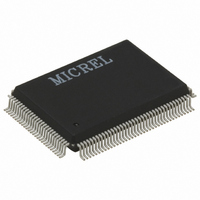KS8997 Micrel Inc, KS8997 Datasheet - Page 19

KS8997
Manufacturer Part Number
KS8997
Description
IC SWITCH 10/100 8PORT 128PQFP
Manufacturer
Micrel Inc
Specifications of KS8997
Applications
*
Mounting Type
Surface Mount
Package / Case
128-MQFP, 128-PQFP
Fiber Support
No
Integrated Led Drivers
Yes
Phy/transceiver Interface
MII
Power Supply Type
Analog/Digital
Package Type
PQFP
Data Rate (typ)
10/100Mbps
Vlan Support
Yes
Operating Temperature (max)
70C
Operating Temperature (min)
0C
Pin Count
128
Mounting
Surface Mount
Jtag Support
No
Operating Temperature Classification
Commercial
Lead Free Status / RoHS Status
Contains lead / RoHS non-compliant
Available stocks
Company
Part Number
Manufacturer
Quantity
Price
Company:
Part Number:
KS8997
Manufacturer:
KENDIN
Quantity:
885
Part Number:
KS8997
Manufacturer:
REALTEK/瑞昱
Quantity:
20 000
Micrel, Inc.
KS8997/KSZ8997
Programmable Features
Priority Schemes
The KS8997 can determine priority through three different means at the ingress point. The first method is a simple
per port method, the second is via the 802.1p frame tag and the third is by viewing the DSCP (TOS) field in the IPv4
header. Of course for the priority to be effective, the high and low priority queues must be enabled on the destination
port or egress point.
Per Port Method
General priority can be specified on a per port basis. In this type of priority all traffic from the specified input port is
considered high priority in the destination queue. This can be useful in IP phone applications mixed with other data
types of traffic where the IP phone connects to a specific port. The IP phone traffic would be high priority (outbound)
to the wide area network. The inbound traffic to the IP phone is all of the same priority to the IP phone.
802.1p Method
This method works well when used with ports that have mixed data and media flows. The inbound port examines the
priority field in the tag and determines the high or low priority. Priority profiles are setup in the Priority Classification
Control in the “EEPROM Memory Map” section.
IPv4 DSCP Method
This is another per frame way of determining outbound priority. The DSCP (Differentiated Services Code Point–
RFC#2474) method uses the TOS field in the IP header to determine high and low priority on a per code point basis.
Each fully decoded code point can have either a high or low priority. A larger spectrum of priority flows can be
defined with this larger code space.
More specific to implementation, the most significant 6 bits of the TOS field are fully decoded into 64 possibilities,
and the singular code that results is compared against the corresponding bit in the DSCP register. If the register bit is
a 1, the priority is high and if 0, the priority is low.
Other Priority Considerations
When setting up the priority scheme, one should consider other available controls to regulate the traffic. One of these
is Priority Control Scheme (register 2 bits 2-3) which controls the interleaving of high and low priority frames. Options
allow from a 2:1 ratio up to a setting that sends all the high priority first. This setting controls all ports globally.
Another global feature is Priority Buffer Reserve (register 2 bit 1). If this is set, there is a 6KB (10%) buffer dedicated
to high priority traffic, otherwise if cleared the buffer is shared between all traffic.
On an individual port basis there are controls that enable DSCP, 802.1p, port based and high/low priority queues.
These are contained in registers 4-11 bits 5-3 and 0. It should be noted that there is a special pin that generally
enables the 802.1p priority for all ports (pin 60). When this pin is active (high) all ports will have the 802.1p priority
enabled unless specifically disabled by EEPROM programming (bit 4 of registers 4-11). Default high priority is a
value of '100' and above in the VLAN tag with low priority being a value of '011' and below.
19
February 2007
M9999-022807-1.1












